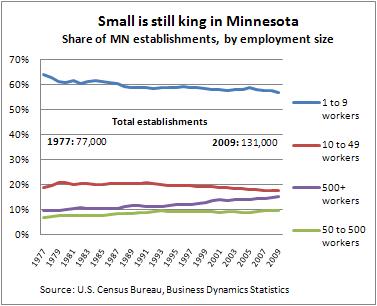It’s widely perceived that today’s economy is ruled by large corporations, and the small business owner doesn’t stand a chance. Drive down any major highway near a big city—it’s hard not to think so given the visual evidence of big-box stores and major office towers.
Though small businesses have lost a small amount of footing in the business world, data from the U.S. Census Bureau suggest that, in fact, state economies are still dominated by small businesses.
From 1977 to 2009, the total number of Minnesota establishments grew by 70 percent, to almost 131,000. Over this period, the share of establishments in Minnesota with fewer than 10 employees dropped slowly, but steadily (see chart). But even today, they account for almost three of five establishments in the state and number more than 75,000.

The chart above is also something of a methodological illusion, making it appear that big businesses are gaining share faster than they actually are—at least on the ground. That’s because establishments are grouped based on the size of the parent company, not necessarily the establishment you see sitting in a new commercial development.
For example, the number and overall percentage of establishments with 500 or more workers have risen steadily in Minnesota for more than 30 years (see the purple line on the chart). But figures for these large firms represent the number of establishments owned by a larger parent company, often headquartered elsewhere.
In 2009 there were about 19,000 establishments in Minnesota owned by parent companies with over 500 employees. Some (unknown number) of these firms also happen to be headquartered in Minnesota and actually employ 500-plus workers in the state. But they can’t all be located in the state, or they would be employing twice as many people as there are in the entire state.
That also explains why there are more establishments with 500-plus employees than there are ones with between 50 and 500 workers—which juxtaposes the rule of thumb that smaller businesses outnumber larger businesses (see the bottom of the chart). This occurs because large firms are more likely than smaller firms to open new locations in different states, and those new establishments—regardless of their actual employment size on the ground—are counted as large ones.
Ron Wirtz is a Minneapolis Fed regional outreach director. Ron tracks current business conditions, with a focus on employment and wages, construction, real estate, consumer spending, and tourism. In this role, he networks with businesses in the Bank’s six-state region and gives frequent speeches on economic conditions. Follow him on Twitter @RonWirtz.





